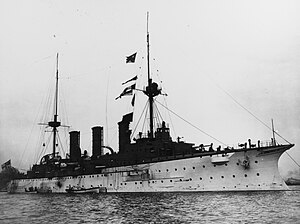 Freya early in her career, before her 1907 reconstruction
| |
| History | |
|---|---|
| Name | Freya |
| Namesake | Freya |
| Builder | Kaiserliche Werft, Danzig |
| Laid down | 2 January 1896 |
| Launched | 27 April 1897 |
| Commissioned | 20 October 1898 |
| Stricken | 25 January 1920 |
| Fate | Scrapped in 1921 |
| General characteristics | |
| Class and type | Victoria Louise-class protected cruiser |
| Displacement | |
| Length | 110.6 m (363 ft) |
| Beam | 17.4 m (57 ft) |
| Draft | 6.58 m (21.6 ft) |
| Installed power |
|
| Propulsion |
|
| Speed | 18.4 knots (34.1 km/h; 21.2 mph) |
| Range | 3,412 nmi (6,319 km; 3,926 mi) at 12 kn (22 km/h; 14 mph) |
| Complement |
|
| Armament |
|
| Armor |
|
SMS Freya was a protected cruiser of the Victoria Louise class, built for the German Imperial Navy (Kaiserliche Marine) in the 1890s, along with her sister ships Victoria Louise, Hertha, Vineta, and Hansa. Freya was laid down at the Imperial Dockyard in Danzig in 1895, launched in April 1897, and commissioned into the Navy in October 1898. The ship was armed with a battery of two 21 cm guns and eight 15 cm guns and had a top speed of 19 knots (35 km/h; 22 mph).
Freya served in the German fleet for the initial years of her career, unlike her sister ships, all of which served abroad on foreign stations. As a result, she led a fairly uneventful career in the fleet. After a modernization in 1905–1907, Freya was used as a school ship for cadets. At the outbreak of World War I, Freya was mobilized into V Scouting Group, but served in front-line duty only briefly. She was used as a barracks ship after 1915, and ultimately sold for scrapping in 1921.